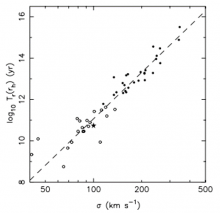
Abstract
In galactic nuclei with sufficiently short relaxation times, binary supermassive black holes can evolve beyond their stalling radii via continued interaction with stars. We study this "collisional" evolutionary regime using both fully self-consistent N-body integrations and approximate Fokker-Planck models. The N-body integrations employ particle numbers up to 0.26×106 and a direct-summation potential solver; close interactions involving the binary are treated using a new implementation of the Mikkola-Aarseth regularization algorithm. Even at these large values of N, two-body scattering occurs at high enough rates in the simulations that they cannot be simply scaled to the large-N regime of real galaxies. The Fokker-Planck model is used to bridge this gap; it includes, for the first time, binary-induced changes in the stellar density and potential. The Fokker-Planck model is shown to accurately reproduce the results of the N-body integrations and is then extended to the much larger N-regime of real galaxies. Analytic expressions are derived that accurately reproduce the time dependence of the binary semimajor axis as predicted by the Fokker-Planck model. Gravitational wave coalescence is shown to occur in <=10 Gyr in nuclei with velocity dispersions below ~80 km s-1. Formation of a core results from a competition between ejection of stars by the binary and resupply of depleted orbits via two-body scattering. Mass deficits as large as ~4 times the binary mass are produced before coalescence. After the two black holes coalesce, a Bahcall-Wolf cusp appears around the single hole in one relaxation time, resulting in a nuclear density profile consisting of a flat core with an inner, compact cluster, similar to what is observed at the centers of low-luminosity elliptical galaxies.